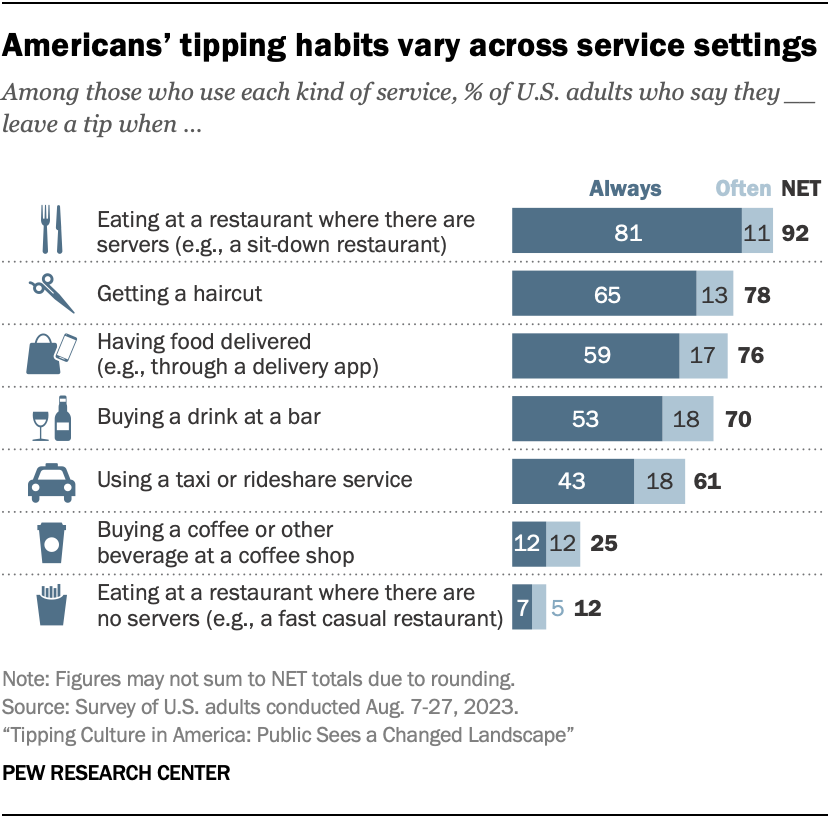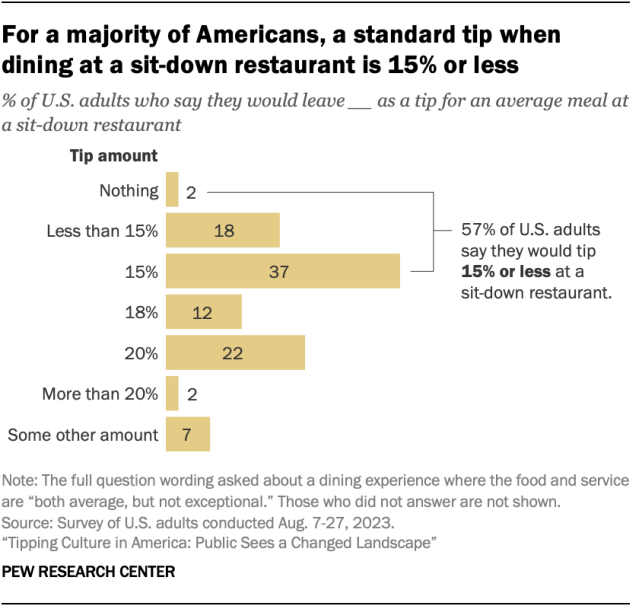The largest share of Americans (49%) say the decision about whether to tip or not depends on the situation. To explore this sentiment further, we asked Americans whether they’d leave a tip in seven specific scenarios that are common in daily life.

Americans report tipping at sit-down restaurants more regularly than in any other scenario we asked about. Some 92% of U.S. adults who dine at sit-down restaurants – that is, one where a server takes their order – say they always or often tip in this situation. That includes 81% who say they always tip in this situation.
Roughly eight-in-ten Americans who get haircuts (78%) say they always or often tip when doing so. A similar share of Americans who have food delivered (76%) report always or often tipping in this situation.
Related: Do You Tip More or Less Than the Average American?
Seven-in-ten U.S. adults who buy drinks at bars say they always or often leave a tip when doing so. And about six-in-ten adults who use taxi or rideshare services (61%) always or often leave a tip.
Tipping is much less common in two other scenarios we asked about. Only a quarter of Americans who buy coffee or other beverages at a coffee shop say they always or often tip in this situation. And just 12% of those who dine at fast casual restaurants – that is, restaurants where there are no servers – always or often leave a tip.
The public’s tipping habits, among those who use each service, vary somewhat by demographic group:
- In most scenarios, upper-income Americans are more likely than those with middle or lower incomes to tip always or often. An exception: Respondents with lower incomes are most likely to report tipping at fast casual restaurants. Even so, only 16% say they always or often do this.
- Americans with at least a bachelor’s degree are more likely to say they always or often tip in nearly all scenarios asked about. But similar shares of those with and without college degrees say they usually tip at coffee shops and fast casual restaurants.
What constitutes an acceptable tip has risen over time, much like the prices of goods and services generally. According to the first (1922) edition of Emily Post’s etiquette book, the rule was 10% for a meal in a “first class hotel,” with a 25-cent minimum. “Tipping is undoubtedly a bad system, but it happens to be in force,” Post wrote, “and that being the case, travelers have to pay their share of it – if they like the way made smooth and comfortable.”
By the latter part of the 20th century, a typical restaurant tip in the U.S. was 15%, according to a historical sketch by economist Ofer Azar. The 1997 edition of Post’s book, cited by Azar, stated, “It wasn’t long ago that 15 percent of the bill, excluding tax, was considered a generous tip in elegant restaurants. Now the figure is moving toward 20 percent for excellent service. In ordinary family-style restaurants 15 percent is still the norm.”
We consulted more than three dozen tipping guides – from food and travel publications to etiquette experts, personal-finance sites and other sources – to get a sense of the current guidance. While specific recommendations vary, 15% is widely deemed the minimum acceptable tip for restaurant service, and 18% to 20% or beyond is frequently advised. One guide, for example, says a tip of 15% to 20% is the norm in sit-down restaurants, but isn’t required at fast-food eateries. Another says the “standard expectation” is 20% at sit-down restaurants and that “10% is now the norm” for quick-service restaurants.
A guide on tipping in the U.S. from the Australian airline Qantas advises 20% to 25% in restaurants and 10% for quick-service, except fast-food chains. The airline adds: “In Australia, where workers are paid a fair minimum wage, a tip is just that – a bonus for great service. Paying extra on top of the bill at a restaurant may seem unnecessary to us but … [t]aking a seat at a restaurant in the US means you’re entering a social contract with your waiter – you can’t apply Australian standards here.”
How much do people tip for a sit-down meal?

Since a large majority of Americans say they usually tip when eating at a sit-down restaurant, we also wanted to know how much of a tip they’d leave. So, we gave our respondents a hypothetical scenario in which they went to a restaurant and had average – but not exceptional – food and service.
In this situation, a majority of Americans (57%) say they would tip 15% or less, including 2% who wouldn’t leave a tip at all. Another 12% of adults say they would leave a tip of 18%, while a quarter say they would tip 20% or more.
Tip amounts vary by income, age and other factors:
- Americans with upper incomes tend to tip more. Upper-income adults are more likely than middle- and lower-income adults to tip 18% or 20% for an average dining experience at a sit-down restaurant. Conversely, those with middle or lower incomes are more likely than upper-income adults to tip 15% or less in this situation.
- Older Americans are slightly more likely than younger adults to tip 15% or less. Among those 65 and older, 61% would leave a tip of 15% or less. That compares with 54% of adults under 30.




